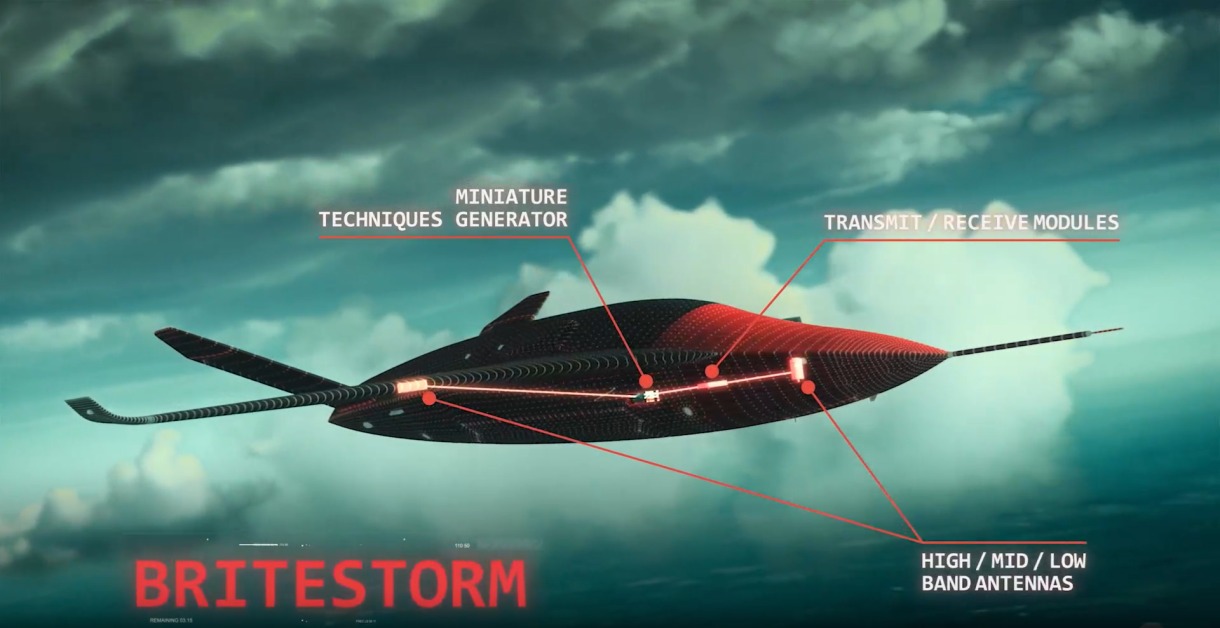Italy’s Leonardo has unveiled its latest electronic warfare (EW) innovation, the BriteStorm system, designed to transform the way armed forces engage in electronic combat.
BriteStorm offers an advanced solution for “stand-in jamming,” allowing both crewed and uncrewed platforms to operate more safely by creating fleets of ‘ghost’ jets to confuse enemy radar systems.
Unlike traditional stand-off jammers, which are mounted on large aircraft positioned far from the battlefield, Leonardo’s stand-in jammer is lightweight, small enough to fit on a drone, and inexpensive enough to be expendable.
The company revealed that the BriteStorm system represents a departure from conventional jamming methods, which typically involve long-range, high-power systems placed well outside the range of enemy threats. Instead, BriteStorm is designed for closer-range operations. It provides an effective means of disrupting enemy air defense systems before they can pose a danger to friendly forces.
Developed at Leonardo’s renowned electronic warfare facility in Luton, UK, BriteStorm has already undergone successful live trials.
The system can be integrated into a variety of platforms, including drones and loitering munitions, further extending its versatility for both current and future military missions.
BriteStorm builds on Leonardo’s earlier technology, BriteCloud, an Expendable Active Decoy (EAD) designed to disrupt radio frequency-guided missiles.

While BriteCloud is primarily used as a last-resort defense, BriteStorm operates earlier in the mission, jamming enemy radars and integrated air defense systems (IADS) to prevent the detection of friendly assets.
According to Mark Randall, Campaign Manager for Electronic Warfare at Leonardo, “Platforms installed with a BriteStorm payload can deploy ahead to create confusion so that enemy IADS are unable to detect, track, and attempt to engage friendly assets. Due to the evolution of near-peer IADS capabilities, it is critical that friendly forces use BriteStorm to ensure they remain protected.”
Andrew Ingram, Head of Capability for Electronic Warfare at Leonardo, added that the stand-in jamming approach reduces the need for high-power systems, making it more suitable for operations in closer proximity to enemy defenses.
This not only increases operational flexibility but also lowers the risks for larger, more vulnerable platforms that would otherwise need to engage from a distance.
The Royal Air Force (RAF) has already received several BriteStorm payloads through its Rapid Capabilities Office (RCO) and has begun flight testing to assess their capabilities.
BriteStorm Capable Of Generating Ghost Formations
The manufacturer said that the BriteStorm system distinguishes itself as the first stand-in jammer on the market equipped with advanced digital radio frequency memory (DRFM) technology, regardless of the platform it’s installed on.
DRFM is regarded as the gold standard in electronic warfare because it allows BriteStorm to capture and replicate an enemy radar system’s pulse with precise accuracy.
Upon detecting an enemy radar signal, BriteStorm uses Leonardo’s cutting-edge DRFM technology to digitally record the radar pulse, analyze it, and respond with either electronic jamming or sophisticated spoofing techniques.
This manipulation can create an array of false targets, such as dozens of “ghost” fighter jets, making it difficult for enemy radars to distinguish between real and fake threats.
This technology is similar to that used in Leonardo’s earlier BriteCloud system, an expendable decoy designed to protect aircraft by disrupting radar-guided missiles.

BriteStorm’s jammers, when deployed on drones or other uncrewed platforms, can enter a target zone from multiple vectors at once. This further complicates the enemy’s defenses by forcing them to divide and misallocate resources.
Leonardo has also incorporated more traditional jamming techniques into BriteStorm, allowing it to disrupt enemy radar by bombarding it with electronic noise. This capability can shield friendly manned and unmanned aircraft during military operations, ensuring their protection by clouding the enemy’s targeting systems.
“BriteStorm is highly effective against radars in the NATO A to J bands,” Leonardo said. “This means that BriteStorm is effective against all types of… surveillance, target acquisition, and tracking radars.”
Moreover, Leonardo views the BriteStorm system as a major advancement over Raytheon’s Miniature Air-Launched Decoy (MALD), an expendable jamming missile that has reportedly also seen action in Ukraine.
While both systems serve to disrupt enemy defenses, Leonardo believes BriteStorm offers enhanced capabilities and greater versatility for modern warfare scenarios.
Leonardo has specifically pointed to several key military programs as potential avenues for integrating the BriteStorm system.
These include the US Army’s Air Launch Effects (ALE) and Future Tactical Uncrewed Aircraft System (FTUAS) programs, the US Air Force’s Collaborative Combat Aircraft (CCA) initiative, and the United Kingdom’s Autonomous Collaborative Platforms (ACP) drone program.
Leonardo sees these programs as prime opportunities for BriteStorm, given the growing focus on uncrewed and collaborative systems in modern defense strategies.
- Contact the author at ashishmichel(at)gmail.com
- Follow EurAsian Times on Google News




